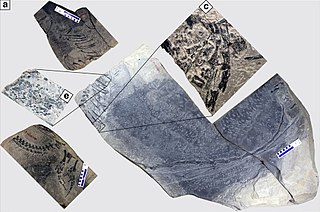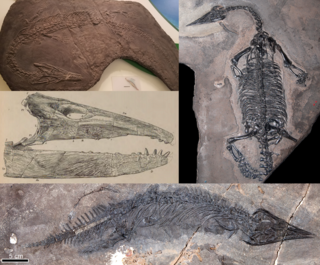
Dinocephalosaurus is a genus of long necked, aquatic protorosaur that inhabited the Triassic seas of China. The genus contains the type and only known species, D. orientalis, which was named by Li in 2003. Unlike other long-necked protorosaurs, Dinocephalosaurus convergently evolved a long neck not through elongation of individual neck vertebrae, but through the addition of neck vertebrae that each had a moderate length. As indicated by phylogenetic analyses, it belonged in a separate lineage that also included at least its closest relative Pectodens, which was named the Dinocephalosauridae in 2021. Like tanystropheids, however, Dinocephalosaurus probably used its long neck to hunt, utilizing the fang-like teeth of its jaws to ensnare prey; proposals that it employed suction feeding have not been universally accepted. It was probably a marine animal by necessity, as suggested by the poorly-ossified and paddle-like limbs which would have prevented it from going ashore.

Thalattosauria is an extinct order of prehistoric marine reptiles that lived in the middle to late Triassic period. Thalattosaurs were diverse in size and shape, and are divided into two superfamilies: Askeptosauroidea and Thalattosauroidea. Askeptosauroids were endemic to the Tethys Ocean, their fossils have been found in Europe and China, and they were likely semiaquatic fish eaters with straight snouts and decent terrestrial abilities. Thalattosauroids were more specialized for aquatic life and most had unusual downturned snouts and crushing dentition. Thalattosauroids lived along the coasts of both Panthalassa and the Tethys Ocean, and were most diverse in China and western North America. The largest species of thalattosaurs grew to over 4 meters (13 feet) in length, including a long, flattened tail utilized in underwater propulsion. Although thalattosaurs bore a superficial resemblance to lizards, their exact relationships are unresolved. They are widely accepted as diapsids, but experts have variously placed them on the reptile family tree among Lepidosauromorpha, Archosauromorpha, ichthyosaurs, and/or other marine reptiles.

Helveticosaurus is an extinct genus of diapsid marine reptile known from the Middle Triassic of southern Switzerland. It contains a single species, Helveticosaurus zollingeri, known from the nearly complete holotype T 4352 collected at Cava Tre Fontane of Monte San Giorgio, an area well known for its rich record of marine life during the Middle Triassic.

Sinosaurosphargis is an extinct genus of basal marine saurosphargid reptile known from the Middle Triassic Guanling Formation of Yunnan and Guizhou Provinces, southwestern China. It contains a single species, Sinosaurosphargis yunguiensis.

Wumengosaurus is an extinct aquatic reptile from the Middle Triassic Guanling Formation of Guizhou, southwestern China. It was originally described as a basal eosauropterygian and usually is recovered as such by phylogenetic analyses, although one phylogeny has placed it as the sister taxon to Ichthyosauromorpha while refraining from a formal re-positioning. It was a relatively small reptile, measuring 95.5–130.5 cm (3.13–4.28 ft) in total body length and weighing 6 kg (13 lb).

Hanosaurus is an extinct genus of marine reptiles that existed during the Triassic period in what is now China. The type species is Hanosaurus hupehensis. It was a small animal, with specimens measuring 79.4 cm (31.3 in) long in total body length, which likely fed on soft-bodied prey.
Qianxisaurus is an extinct genus of pachypleurosaur or alternatively a basal eosauropterygian known from the Middle Triassic of Guizhou Province, southwestern China. It contains a single species, Qianxisaurus chajiangensis.
Majiashanosaurus is an extinct genus of pachypleurosaur or alternatively a basal eosauropterygian known from the Early Triassic of Anhui Province, eastern China. It contains a single species, Majiashanosaurus discocoracoidis.
Sanchiaosaurus is an extinct genus of a basal nothosauroid known from the Middle Triassic of Guizhou Province, southwestern China. It contains a single species, Sanchiaosaurus dengi.
Kwangsisaurus is an extinct genus of a basal pistosauroid known from the Early or Middle Triassic of Guangxi, southern China. It contains a single species, Kwangsisaurus orientalis.

Saurosphargidae is an extinct family of marine reptiles known from the Early Triassic and early Middle Triassic of Europe and China.
Saurosphargis is an extinct genus of a basal marine reptile, saurosphargid, known from the Middle Triassic of southwestern Poland and eastern Netherlands. It contains a single species, Saurosphargis volzi.

Eusaurosphargis is an extinct genus of a diapsid reptile, known from the Middle Triassic Besano Formation of northern Italy and Prosanto Formation of south-eastern Switzerland. It contains a single species, Eusaurosphargis dalsassoi. It was a small reptile, measuring 20 cm (7.9 in) long.

Helveticosauridae is an extinct family of basal marine reptiles known from the Middle Triassic of southern Switzerland and northern Italy.

Pectodens is an extinct genus of archosauromorph reptile which lived during the Middle Triassic in China. The type and only species of the genus is P. zhenyuensis, named by Chun Li and colleagues in 2017. It was a member of the Archosauromorpha, specifically part of the unnatural grouping Protorosauria. However, an unusual combination of traits similar and dissimilar to other protorosaurs initially led to confusion over its evolutionary relationships. In 2021, it was placed in a newly-established group, Dinocephalosauridae, along with its closest relative Dinocephalosaurus.
The Zhuganpo Formation is a Triassic geologic unit found in southern China. It has historically been known as the Zhuganpo Member of the Falang Formation. A diverse fossil assemblage known as the Xingyi biota or Xingyi Fauna can be found in the upper part of the Zhuganpo Formation. Fossils of the Xingyi biota include articulated skeletons of marine reptiles, abundant fish, and a plentiful assortment of invertebrates indicating a Ladinian to Carnian age for the sediments of the formation.
Panzhousaurus is an extinct genus of pachypleurosaur from the Middle Triassic of China. The type species is P. rotundirostris. The preserved portion of the holotype measures 36 cm (14 in) long, and its total body length may have been less than 50 cm (20 in).
Dianmeisaurus is an extinct genus of pachypleurosaur from the Middle Triassic Guanling Formation in China. The type species is D. gracilis.

Luopingosaurus is an extinct genus of pachypleurosaurid sauropterygian from the Middle Triassic Guanling Formation of Yunnan Province, China. The genus contains a single species, L. imparilis, known from a well-preserved, nearly complete skeleton.
Gracilicollum is a genus of likely tanystropheid archosauromorph from the Middle Triassic (Anisian) Guanling Formation of China. The genus contains a single species, G. latens, known from a skull and partial neck.

















